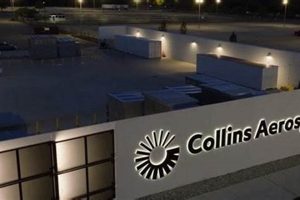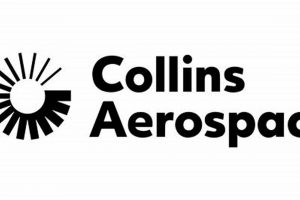Collins Aerospace is a significant player in the global aerospace and defense industry, specializing in the design, manufacture, and support of technologically advanced systems and products. The organization’s output encompasses a wide array of solutions, including avionics, aerostructures, interiors, mechanical systems, mission systems, and power and control systems. These diverse products are integrated into both commercial and military aircraft, as well as other platforms within the defense sector.
The company’s contributions are vital for ensuring aircraft safety, efficiency, and passenger comfort. Their products enhance flight operations, improve aircraft performance, and provide critical communication and navigation capabilities. The long history of innovation in areas such as flight controls and cabin management systems has helped shape the evolution of air travel and military aviation. Collins Aerospace’s role in supporting advanced aerospace capabilities and security has had a tangible effect on industries across the globe.
The following discussion will provide a more detailed overview of specific product categories offered by this organization, highlighting representative examples and their applications within the aerospace and defense markets.
Understanding the breadth of Collins Aerospace’s offerings is essential for industry professionals, researchers, and prospective clients. The following guidelines provide a framework for effectively exploring and utilizing the company’s product portfolio.
Tip 1: Leverage the Official Website: The Collins Aerospace website is the primary source for up-to-date information on its products and services. Explore the product categories, download datasheets, and review case studies to gain a comprehensive understanding. For example, detailed specifications for its Pro Line Fusion avionics suite are readily available.
Tip 2: Categorize by Aerospace Segment: Collins Aerospace structures its offerings based on application segment. Differentiate between solutions for commercial aviation, business aviation, military, and space. For instance, cabin interiors and entertainment systems are predominantly tailored for commercial airlines, while ruggedized communication systems are designed for military applications.
Tip 3: Identify Core Product Lines: Focus on the key product lines within each segment. These include avionics, aerostructures, interiors, mechanical systems, mission systems, and power & control systems. A deep dive into these product areas will offer a greater understanding of the organization’s specialization.
Tip 4: Understand System Integration: Many Collins Aerospace products are designed to be integrated into larger systems. Consider how components like flight control systems and communication networks interact to achieve overall aircraft performance. Integration expertise is a key differentiator.
Tip 5: Examine Regulatory Compliance: Aerospace products are subject to stringent regulatory requirements. Confirm that the solutions under consideration meet the relevant certifications and standards, such as FAA or EASA requirements. This is critical for safe and legal operation.
Tip 6: Explore Support and Maintenance Services: Collins Aerospace offers comprehensive support and maintenance services. Inquire about the availability of training, spare parts, and repair services to ensure the long-term reliability and operational readiness of their products.
These suggestions offer a strategic approach to understanding the products developed by Collins Aerospace, focusing on its breadth, segmentation, key offerings, integrated systems, regulatory compliance, and support infrastructure.
Understanding Collins Aerospace’s diverse offerings enables stakeholders to appreciate its crucial contribution to the advancement of the aerospace and defense sectors.
1. Avionics Systems
Avionics systems represent a core element of the product portfolio of Collins Aerospace. The company develops and manufactures a comprehensive suite of avionics solutions, impacting flight control, navigation, communication, and surveillance capabilities across diverse aircraft platforms. This integral relationship underscores the significant contribution of avionics systems to what Collins Aerospace produces, as they represent a substantial segment of the organization’s overall output. The development, production, and support of such complex, safety-critical systems have substantial effects on aircraft performance and operational efficiencies.
Examples of Collins Aerospace’s avionics systems include flight management systems, display systems, communication radios, weather radars, and surveillance equipment. These products enhance situational awareness for pilots, facilitate safe and efficient navigation, and improve communication with air traffic control. For example, the Pro Line Fusion integrated avionics system, developed by Collins Aerospace, is deployed on numerous business jets and regional airliners. This illustrates the company’s capacity to integrate multiple avionics functions into a cohesive, user-friendly interface. As a result, flight crew workload is reduced and the overall performance of the aircraft is improved.
In summary, avionics systems are crucial to what Collins Aerospace makes, impacting all the operational dimensions of the aerospace industry. Understanding this relationship emphasizes the dependence of modern aviation on sophisticated avionics technology and recognizes Collins Aerospace’s substantial contribution in developing and maintaining these vital systems. The companys avionics solutions increase flight safety, improve efficiency, and enhance the overall operational performance of modern aircraft.
2. Aircraft interiors
Aircraft interiors constitute a significant portion of the product offerings of Collins Aerospace. The design, manufacture, and integration of these interiors contribute directly to the overall passenger experience and airline operational efficiency. As a core component of what Collins Aerospace produces, aircraft interiors impact factors such as cabin weight, seat comfort, inflight entertainment, and lavatory systems. Consequently, advancements in interior design and technology directly affect airline profitability and passenger satisfaction.
Collins Aerospace provides a comprehensive range of interior solutions, encompassing seating, lighting, galleys, lavatories, overhead bins, and cabin management systems. These components are integrated to create a cohesive and functional cabin environment. For instance, the company’s Meridian business-class seat incorporates advanced ergonomic design and lightweight materials to enhance passenger comfort and reduce fuel consumption. Furthermore, Collins Aerospace offers advanced inflight entertainment systems, such as its Venue platform, delivering enhanced connectivity and streaming capabilities. These systems significantly contribute to passengers overall journey experience.
The organization’s commitment to aircraft interiors significantly influences the aerospace market and passenger experiences. The importance of interior design for enhancing passenger satisfaction, operational efficiency, and overall brand image establishes the integration of aircraft interiors as a crucial aspect of what Collins Aerospace produces. By emphasizing innovation in interior design and production, Collins Aerospace significantly impacts the commercial aviation sector.
3. Aerostructures
Aerostructures form a critical segment of Collins Aerospace’s manufacturing activities. Their design, fabrication, and integration are integral to the structural integrity and aerodynamic performance of aircraft. The specific aerostructures developed by the company significantly contribute to the overall composition of what Collins Aerospace manufactures.
- Wing Components
Collins Aerospace produces a variety of wing components, including wing skins, spars, and leading edges. These components are engineered to withstand substantial aerodynamic loads and contribute to the overall lift and stability of the aircraft. The production of these crucial wing elements showcases Collins Aerospace’s proficiency in advanced materials and manufacturing processes. Examples include the wing structures for regional jets and business aircraft, demonstrating the company’s impact across diverse aircraft types.
- Fuselage Sections
Fuselage sections, encompassing both forward, center, and aft sections, represent another significant aerostructure produced by Collins Aerospace. These sections form the main body of the aircraft and are crucial for housing passengers, cargo, and essential systems. The construction of these fuselage segments requires expertise in joining techniques, such as riveting and composite bonding, ensuring structural integrity under varying flight conditions. Collins Aerospace’s contribution to fuselage manufacturing is evident in its partnerships with major aircraft manufacturers.
- Empennage Structures
The empennage, or tail section, is a vital aerostructure for aircraft stability and control. Collins Aerospace manufactures horizontal and vertical stabilizers, along with control surfaces such as rudders and elevators. These components are designed to provide the necessary aerodynamic forces for maneuvering the aircraft. The precision engineering and manufacturing of empennage structures directly influence aircraft handling characteristics and safety.
- Nacelles and Pylons
Nacelles, which house the aircraft engines, and pylons, which attach the engines to the wings or fuselage, are also key aerostructures produced by Collins Aerospace. These structures must withstand extreme temperatures, vibrations, and aerodynamic forces. The design and manufacturing of nacelles and pylons require expertise in thermal management and structural dynamics. Collins Aerospace’s involvement in these areas demonstrates its comprehensive aerostructure capabilities.
In summation, the aerostructures segment is central to the diverse portfolio of products that Collins Aerospace manufactures. Its impact extends across a multitude of aircraft platforms, influencing both the structural integrity and performance capabilities of modern aircraft. The continued advancement in aerostructure design and manufacturing will remain critical to the evolution of the aerospace industry and the overall products that Collins Aerospace provides.
4. Mechanical systems
Mechanical systems constitute a significant and interconnected component of what Collins Aerospace manufactures. These systems are fundamental to aircraft operation, influencing performance, safety, and overall efficiency. The design, production, and integration of mechanical systems reflect a substantial allocation of resources and expertise within the company. Understanding these systems is crucial to comprehending the complete scope of the organization’s activities. Examples of these systems include actuation systems, which control flight surfaces; braking systems, essential for safe landings; and environmental control systems, ensuring passenger comfort and safety by regulating cabin pressure and temperature.
The importance of mechanical systems in the Collins Aerospace product portfolio is underscored by their direct impact on aircraft functionality. For example, the company produces advanced actuation systems that enable precise control of wing flaps and slats, optimizing aerodynamic performance during takeoff and landing. These systems rely on complex hydraulic and electromechanical components, designed and manufactured to stringent aerospace standards. Similarly, the environmental control systems are critical for maintaining a habitable environment within the aircraft cabin, especially at high altitudes. These systems integrate temperature regulation, air filtration, and pressurization, all working in concert to ensure passenger and crew well-being. The reliability and performance of these systems directly correlate to aircraft safety and operational effectiveness.
In conclusion, mechanical systems are essential components of what Collins Aerospace provides, acting as foundational elements for modern aircraft capabilities. Their continuous development and refinement play a key role in the advancement of the aerospace industry, influencing aircraft performance, safety, and passenger comfort. The ability to integrate complex mechanical solutions within larger aerospace systems emphasizes the importance of this segment of what Collins Aerospace manufactures.
5. Mission systems
Mission systems represent a specialized and technologically advanced segment of what Collins Aerospace manufactures. These systems are tailored for military and government applications, delivering enhanced capabilities for intelligence gathering, surveillance, reconnaissance, and command and control. The integration of mission systems into aircraft and other platforms significantly augments their operational effectiveness in complex and dynamic environments.
- Intelligence, Surveillance, and Reconnaissance (ISR) Systems
Collins Aerospace develops and integrates a variety of ISR systems, including advanced sensors, radar systems, and data processing capabilities. These systems enable the collection and analysis of critical intelligence, enhancing situational awareness for military commanders. Examples include long-range surveillance radars deployed on maritime patrol aircraft and high-resolution imaging systems used for tactical reconnaissance. The data generated by these systems directly informs strategic decision-making and operational planning.
- Communication and Networking Systems
Secure and reliable communication is paramount for mission success. Collins Aerospace provides advanced communication and networking solutions that enable seamless information sharing between airborne, land-based, and naval assets. These systems incorporate encryption, anti-jamming technologies, and robust network architectures to ensure secure communication in contested environments. Examples include satellite communication terminals and tactical data links that facilitate real-time information exchange among diverse platforms.
- Electronic Warfare (EW) Systems
Electronic warfare systems are designed to detect, identify, and neutralize enemy electronic threats. Collins Aerospace develops EW systems that provide critical self-protection capabilities for military aircraft and naval vessels. These systems can disrupt enemy radar systems, communication networks, and electronic weapons, enhancing platform survivability in hostile environments. Examples include radar jammers and electronic countermeasures systems deployed on fighter aircraft and electronic warfare aircraft.
- Command and Control (C2) Systems
Effective command and control is essential for coordinating military operations. Collins Aerospace provides C2 systems that enable military commanders to monitor the battlespace, assess threats, and issue orders to subordinate units. These systems integrate data from multiple sources, providing a comprehensive operational picture. Examples include battlefield management systems and command and control centers that facilitate real-time decision-making and resource allocation.
The incorporation of sophisticated mission systems significantly expands the utility of military platforms and strengthens national security capabilities. By delivering advanced technologies for intelligence gathering, secure communication, electronic warfare, and command and control, Collins Aerospace plays a vital role in supporting the defense sector and enhancing the operational effectiveness of military forces worldwide. The ongoing development and integration of mission systems remain a critical aspect of what Collins Aerospace produces.
6. Power controls
Power control systems represent a crucial category within the array of products manufactured by Collins Aerospace. These systems govern the generation, distribution, and management of electrical power within aircraft, playing a vital role in the operation of various onboard systems. This aspect is central to a comprehensive understanding of what Collins Aerospace contributes to the aerospace industry.
The functionality of power control systems directly impacts the reliability and efficiency of aircraft operations. Collins Aerospace designs and produces a range of power control solutions, including generators, power distribution units, and control software. These components work in concert to ensure a stable and consistent power supply for avionics, flight control systems, lighting, and passenger amenities. For example, their advanced power generation systems are employed on numerous commercial and military aircraft, contributing to improved fuel efficiency and reduced emissions. These systems minimize power consumption, thus optimizing aircraft performance and lowering operational expenses.
In summary, power control systems are indispensable components of what Collins Aerospace delivers to the aerospace market. The development and integration of advanced power control technologies contribute directly to the safety, reliability, and efficiency of modern aircraft. Understanding this connection highlights the significance of power control systems in aircraft operations and underscores the pivotal role of Collins Aerospace in advancing these technologies.
7. Connectivity
Connectivity represents an increasingly critical element of Collins Aerospace’s product portfolio. It encompasses the systems and technologies that enable communication, data transfer, and network integration within and between aircraft, ground stations, and other aerospace assets. As a key component of what Collins Aerospace produces, connectivity solutions directly affect operational efficiency, passenger experience, and overall system performance. The demand for robust and reliable connectivity is driven by the growing need for real-time data exchange, enhanced communication capabilities, and seamless integration of aircraft into the digital ecosystem. The effects of incorporating advanced connectivity are evident in improved air traffic management, enhanced maintenance diagnostics, and enriched passenger entertainment options.
The practical applications of Collins Aerospace’s connectivity solutions are diverse and far-reaching. High-speed internet access for passengers, enabled by satellite-based communication systems, has become a standard expectation on commercial flights. Furthermore, secure data links for military aircraft facilitate real-time intelligence sharing and coordinated operations. The companys offerings also include connectivity solutions that support predictive maintenance, enabling airlines to proactively address potential equipment failures and minimize downtime. In the realm of air traffic management, enhanced connectivity enables more precise navigation and optimized flight paths, contributing to reduced fuel consumption and improved airspace utilization. As an example, Rockwell Collins’ ARINC Globalink provides secure and reliable communication services for airlines and business aviation operators worldwide.
In conclusion, connectivity is a defining factor in the evolution of Collins Aerospace’s product offerings. Its impact spans across multiple facets of the aerospace industry, influencing operational efficiency, security, and passenger satisfaction. As the demand for seamless and reliable communication continues to escalate, connectivity solutions will remain a central focus of Collins Aerospace’s innovation efforts, thereby shaping the future of air travel and defense applications. Challenges remain in ensuring secure and resilient connectivity in congested airspace and contested environments, necessitating ongoing research and development in this critical domain.
Frequently Asked Questions
This section addresses common inquiries concerning the products manufactured by Collins Aerospace, providing clarity on their scope, applications, and impact within the aerospace and defense industries.
Question 1: What is the primary focus of Collins Aerospace’s manufacturing activities?
The organization specializes in the design, production, and support of advanced systems and components for the aerospace and defense sectors. This encompasses a wide range of products, including avionics, aerostructures, interiors, mechanical systems, mission systems, and power controls.
Question 2: In which aerospace segments are Collins Aerospace products utilized?
Products are deployed across commercial aviation, business aviation, military aviation, and space programs. Solutions are tailored to meet the specific requirements of each segment, considering factors such as performance, safety, and operational environment.
Question 3: What are examples of avionics systems produced by Collins Aerospace?
The company manufactures flight management systems, display systems, communication radios, weather radars, and surveillance equipment. These systems enhance situational awareness for pilots and contribute to safe and efficient navigation.
Question 4: What types of aircraft interiors are manufactured by Collins Aerospace?
Collins Aerospace provides a comprehensive range of interior solutions, including seating, lighting, galleys, lavatories, overhead bins, and cabin management systems. These components are designed to improve passenger comfort and enhance airline operational efficiency.
Question 5: What kind of mission systems are developed by Collins Aerospace for military applications?
The company develops systems for intelligence gathering, surveillance, reconnaissance, command and control, electronic warfare, and communication networking. These systems augment the operational effectiveness of military platforms in complex environments.
Question 6: What is the significance of power control systems in the Collins Aerospace product line?
Power control systems govern the generation, distribution, and management of electrical power within aircraft. These systems contribute to the reliability and efficiency of aircraft operations, ensuring a stable power supply for critical onboard systems.
In summary, the product portfolio of Collins Aerospace spans a wide spectrum of aerospace and defense applications, delivering technologically advanced solutions that enhance performance, safety, and operational effectiveness.
The subsequent discussion will explore the future trends and innovations shaping the evolution of Collins Aerospace’s product offerings.
Conclusion
This exploration of what Collins Aerospace makes reveals a diverse and significant contribution to the aerospace and defense industries. Its products span multiple critical areas, from avionics and aerostructures to interiors, mechanical systems, mission systems, connectivity and power controls, collectively supporting both commercial and military platforms. These technologies play a pivotal role in enabling flight, enhancing safety, improving efficiency, and expanding the capabilities of modern aircraft.
The continued innovation and advancement of these offerings will be essential for addressing the evolving challenges and opportunities within the aerospace sector. Further research and development in areas such as sustainable aviation, autonomous systems, and secure communication will drive the future direction of the organization’s product portfolio and the industries it serves.







